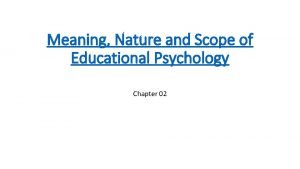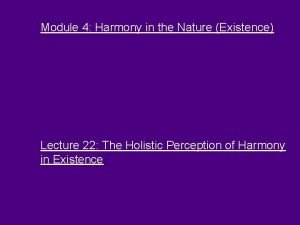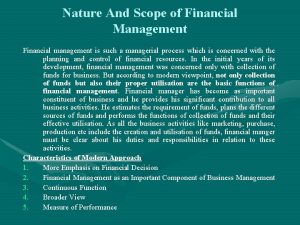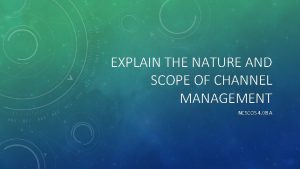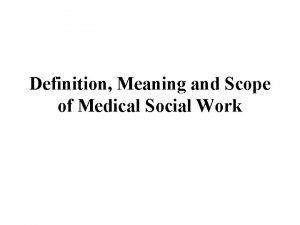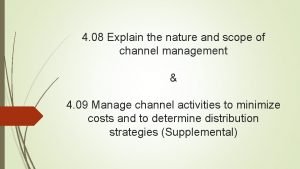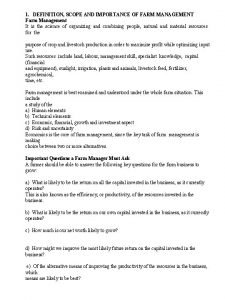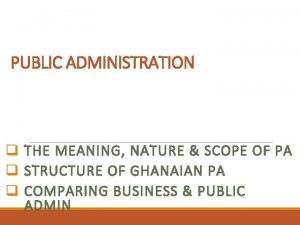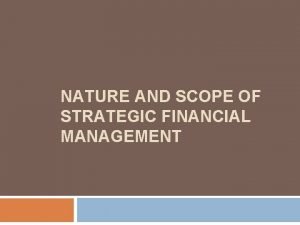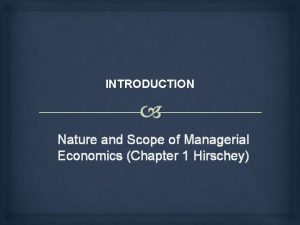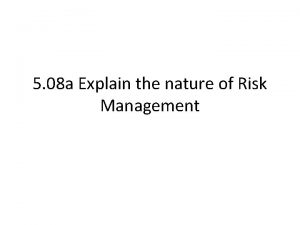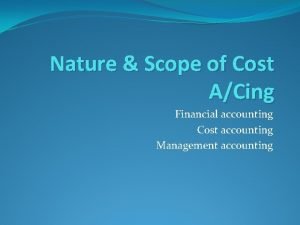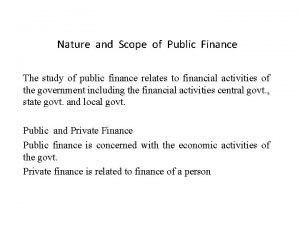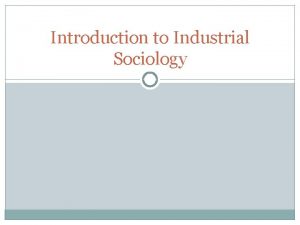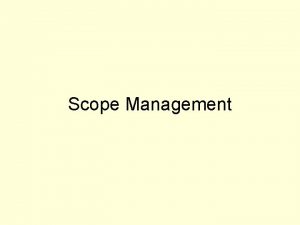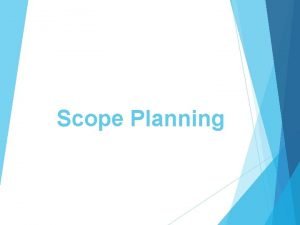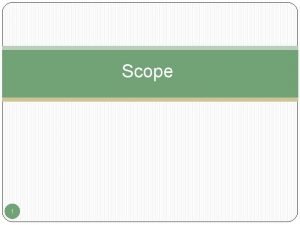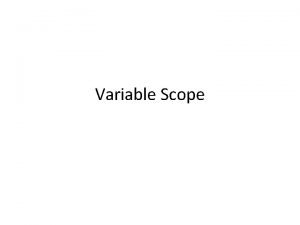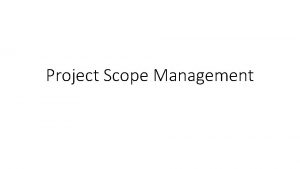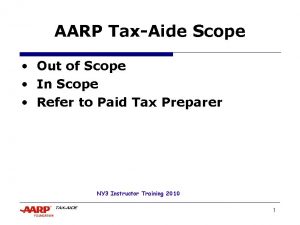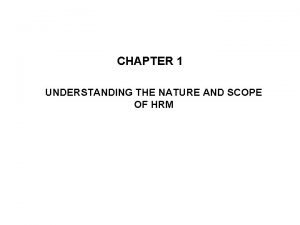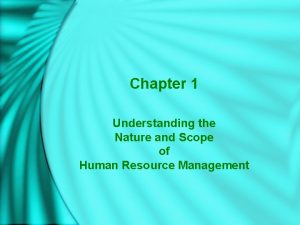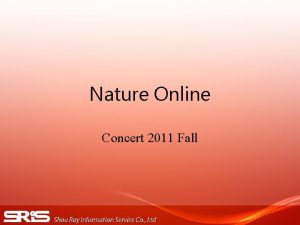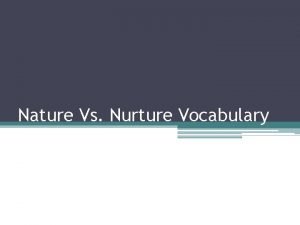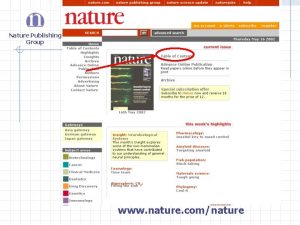Chapter 1 Understanding the Nature and Scope of



















- Slides: 19

Chapter 1 Understanding the Nature and Scope of Human Resource Management, 5 E 1

Learning Objectives • Understand the Nature, Scope and Objectives of Human Resource Management. • Design an Organisation Chart for Human Resource Management Function in a Typical Industrial Establishment. • Understand the Personnel Principles and Policies. • Trace the Evolution of Human Resource Management. • Understand Human Capital Management • Identify Jobs and Careers in HRM. Human Resource Management, 5 E 2

Meaning and Definition • People’s dimension • Organisational effectiveness Scope of HRM • Enters • Works • Exits Human Resource Management, 5 E 3

Scope of HRM Nature of HRM Prospects of HRM Employee Hiring HRM Employee & Executive Remuneration Industrial Relations Employee Maintenance Employee Motivation Human Resource Management, 5 E 4

Difference between PM and HRM • • • • Personnel Management Careful delineation of written contracts Importance of devising clear rules Procedures Norms/customs and practices Monitoring Labour management Piecemeal Slow Transactional Indirect Negotiation Separate, marginal task Job evaluation • • HRM Aim to go beyond contract Can do outlook, impatience with rule Business need Values/mission • • • Nurturing Customer Integrated Fast Transformational leadership direct facilitation Integrated key tasks Performance related • • Human Resource Management, 5 E 5

Difference between PM and HRM • • • Personnel Management Separately negotiated Collective bargaining contracts Many Division of labour Reach temporary truce Controlled access to courses personnel procedures Labour is treated as a tool which is expendable and replaceable Interests of the organisation are uppermost Precedes HRM external • • • HRM harmonisation Individual contract Few Team work Manage climate and culture Learning companies wide ranging culture, structural and personnel strategies. People are treated as assets to be used for the benefit of an organisation, its employees and the society as a whole. Mutuality of interests Latest in the evaluation of the subject internal Human Resource Management, 5 E 6

Semantics – HRM vs. PM • Mutuality • Labour management • Legal compliance HRD and IRM – What are they? • Segments of HRM Human Resource Management, 5 E 7

Composition of a HR / Personnel Department Owner/Manager. Administration Manager-Personnel Manager-HRD Appraisal PR HRP Canteen Hiring Medical Manager-IR Training & Development Welfare Grievances Handling Human Resource Management, 5 E Transport Legal Compensation 8

Objectives of HRM Personal Objectives Functional Objectives Organisational Objectives Societal Objectives Human Resource Management, 5 E 9

HRM Small-scale Unit Owner/Manager Production Manager Sales Manager Office-Manager Accountant Personnel Assistant Human Resource Management, 5 E 10

HRM Large-scale Unit Chairman and Managing Director Production Director Finance Director Personnel/HRM Human Resource Management, 5 E Director Marketing Director R&D 11

Paradoxes in HRM • Only hype but low on content • Has grown from IR to PM to HRM. But HRM is brilliant ambiguity. • HR Manager is change agent and transformationalist. • Finance overtakes personnel function. Human Resource Management, 5 E 12

Personnel Policies at ABB India • • • Role clarity Empowerment Take responsibility Competence development Clearly defined objectives for individual and the work team Human Resource Management, 5 E 13

Personnel Policies at ABB India • The local unions as natural co-operation partners • Planning discussions held at least once a year • Internal mobility and employee development • Ethics, equal opportunities and an open and honest exchange of thoughts and ideas • A strategic issue Human Resource Management, 5 E 14

Evolution of HRM in India 1920 s – 30 s Pragmatism of capitalists 1940 s – 50 s Technical, legalistic 1970 s – 80 s Professional, legalistic, impersonal 1990 s Philosophical Human Resource Management, 5 E 15

Jobs & Careers in HRM • HR Specialist • HR Manager • HR Executive • Why Study HRM? Human Resource Management, 5 E 16

Reality Check • It is good to read that people management has matured from IR to PM to HRM to HCM. But has the change been only cosmic or real? Have a debate. Human Resource Management, 5 E 17

Reality Check • Should this happen? Would this happen? Could this happen? How could all HR activities be outsourced? Can a firm function with a HR department organised on perfunctionary basis? Answer these questions. Human Resource Management, 5 E 18

Reality Check • Looking at the four models described in this section, what similarities and dissimilarities do you notice among them? What assumptions to they make? What lessons do they carry to practising HR managers and students of HRM? Human Resource Management, 5 E 19
 Educational psychology nature
Educational psychology nature Explain the holistic perception of harmony in existence
Explain the holistic perception of harmony in existence Scope of physics
Scope of physics Nature and scope financial management
Nature and scope financial management What is marketing nature scope and importance
What is marketing nature scope and importance Scope and nature of managerial economics
Scope and nature of managerial economics Explain the nature and scope of channel management.
Explain the nature and scope of channel management. Scope of medical social work pdf
Scope of medical social work pdf What is nature of risk
What is nature of risk Explain the nature and scope of channel management
Explain the nature and scope of channel management Nature and scope of farm management
Nature and scope of farm management Nature and scope of clinical psychology
Nature and scope of clinical psychology Public administration meaning nature and scope
Public administration meaning nature and scope Scope of strategic financial management
Scope of strategic financial management Accounting scope
Accounting scope Managerial economics nature and scope
Managerial economics nature and scope Retrospective risk
Retrospective risk Nature of cost accounting
Nature of cost accounting Nature of public finance
Nature of public finance Industrial sociology
Industrial sociology
